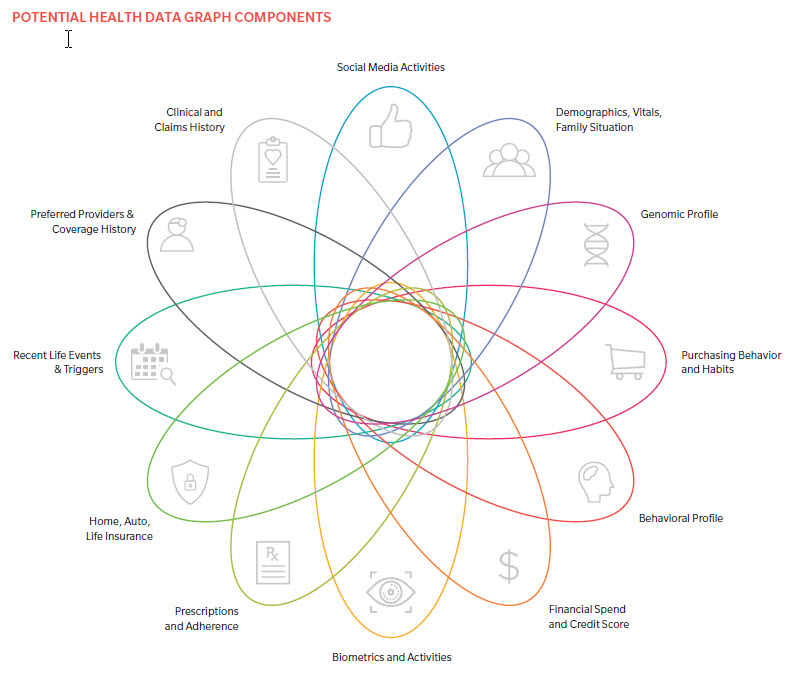Editor's Note: This article was originally published in the 2018 Oliver Wyman Health Innovation Journal.
Healthcare companies need to do more. Firms that effectively recognize patterns across disparate data sets, discerning differences between consumer segments and behaviors to engage people differently, stand to create and capture tremendous future value. This means being deliberate about data acquisition (and consumer trust), having the right set of science and analytics to give data meaning, and meeting consumers where they are, based on their personal needs.
STEP 1: EXPANDING THE HEALTH DATA GRAPH
Traditional health data is highly siloed and transaction oriented, providing insight into only a limited portion of consumers’ overall health situation and needs through clinical and claims data. A data graph, however, is not a traditional “graph” per se. Rather it’s a structure that captures multiple relationships between different entities and data points. Think Facebook and the social graph. LinkedIn and the professional graph. Pinterest and the interest graph.
Tomorrow’s health data graph will incorporate a combination of traditional clinical and claims data, new health monitoring (such as activity and biometrics), behavioral observations (such as social media, geolocation, and financial activity), and more. Available data will become broader (within and beyond health), more granular, and more real-time.
There is movement beyond traditional data silos today. New devices readily available on the consumer market are potential springboards for better awareness and prevention, using data to foster deeper patient-provider relationships. For instance, Apple recently announced its Apple Watch Series 4, with a Food and Drug Administration-approved electrocardiogram that communicates patients’ live heart rate data to their physicians. The watch can also share any health information a patient enters directly into his or her phone (such as any recent symptoms, heart or fitness data, and information about sleep, wellness, and diet) with a physician to encourage informed, ongoing conversations.
The startup Tempus is investing in using clinical and genetic data to advance cancer treatments. Last January, Tempus announced a partnership with the NYU School of Medicine where an analysis of genomic sequencing data will help physicians develop personalized pancreatic cancer treatments. Tempus will organize and review data from nearly 500 pancreatic cancer patients to improve prognoses of patients’ responses to treatment.
Socially Determined, another medical innovator, uses massive amounts of publicly available contextual consumer data (from census, housing and real estate reports, and more) to build holistic models around people, their communities, and their healthcare system interactions, and is tying its financial success to financial and clinical client outcomes.
Examples like these are the outliers. In practice, most incumbents have seen minimal movement beyond traditional data silos, and are largely operating with structured claims and clinical data. To get to where we want to go – robust, real-time, situational understanding – we need to close the gap. Incumbents must incorporate more relevant real-time data, meaningful to the problems being solved.
KEY CONSIDERATIONS: TRUST AND DATA OWNERSHIP GO HAND IN HAND
Privacy regulation will increase. Beyond HIPAA, GDPR is already having an impact on businesses globally and is likely to influence future US policy decisions. These regulations require transparency in how information is used and give consumers more control over their data.
Cyber risk is real. A data breach is more expensive in healthcare than any other industry – almost triple cross-industry average. Using data from multiple disparate sources increases the surfaces of attack. Not having a robust cyber risk-management strategy could cost millions of dollars, and infinitely more in consumer trust.
New tech will shape data ownership. Many technologies (like Apple’s health app) are starting to give consumers ownership of their data and aggregate distributed data in a shareable, secure way. Blockchain-based solutions could take this to the extreme, giving data ownership back to users through the use of encryption keys, allowing them to determine who to share it with.
STEP 2: DRIVING ACTION THROUGH INSIGHTS (DATA IS NOT ENOUGH)
Data in search of strategy is not where you want to be. Winners will effectively put data to use by recognizing patterns across disparate data sets and use those insights to drive differentiated consumer recommendations. Meeting consumers at the right time and right place to drive action requires “knowing them better than they know themselves.” Creating correlations between consumers’ profiles, who consumers are – and what that implies about their motivations – is a combination of data, data science, behavioral science, and psychology. This idea is trifold:
- Behavioral psychology must differentiate between motivational and personality-driven characteristics (such as risk tolerance and impulsivity).
- Data science must extract meaningful relationships between consumer profile and action.
- Experiments must be run to understand behavioral engagement drivers and test hypotheses about individuals’ motivations and behaviors.
The goal is purposeful intervention that aligns with unique motivations. This comes though increased relevance, quality, and frequency of touches. This way, curated solutions come at the right time, right place, and right context.
AN EXAMPLE: WHAT DOES THE EMPLOYER HEALTH DATA GRAPH LOOK LIKE IN ACTION?
Employers have more data on hand than they realize, likely more than most healthcare companies have. There’s the obvious employment history, benefits selections, and health assessments, but also less obvious information about financial habits, savings profile, and consumption patterns. Further, employers are sitting on a vast amount of data about people’s motivations in the form of both personality profiles (like Myers-Briggs) and direct observations that garner information on the reasons behind someone’s impulses and desires. For example, when someone is prompted to complete a training or survey, his or her employer likely knows if it was completed upon first notice, before or after a deadline, or not at all – and what stimuli perhaps got the person to complete it. This, combined with the more obvious data above, can help create a motivational profile that enables employers to serve health recommendations to employees differentially.
We know consumers are willing to share their data for the right reasons. According to the most recent Oliver Wyman consumer survey, almost 90 percent of consumers were willing to share personal health data, and nearly 85 percent were willing to share shopping behaviors when there was some kind of return.
The impetus is on us. Success is not obvious and will require deeper consumer understanding, robust data science, and a willingness to experiment, pilot, and learn quickly to de-risk disruptive options. But, like employers, most incumbents have more data on hand than they realize and need to create more data-centric business and engagement models.




